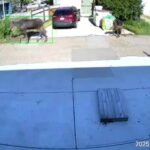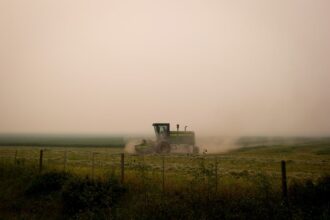In a stark reminder of wildlife’s unpredictable nature, a 71-year-old Edmonton woman narrowly escaped with her life after being trampled by a moose in her own backyard last week. The terrifying incident has raised urgent questions about wildlife management in urban areas and the increasing frequency of dangerous human-animal interactions.
Sandra Lott was enjoying a peaceful morning in her Mill Woods backyard when the unexpected encounter occurred. “I stepped out to hang some laundry and suddenly this massive shape came charging at me,” Lott recounted from her hospital bed, where she’s recovering from multiple injuries including broken ribs, a fractured pelvis, and extensive bruising.
The moose, estimated to weigh approximately 700 kilograms, had apparently been foraging in the area for several days prior to the attack. Neighbors reported sightings of the animal, but no official warnings had been issued to residents.
“The force was incredible,” said Lott. “It knocked me down immediately and continued to stomp. I curled into a ball and thought this was the end.”
Wildlife officials from Alberta Fish and Wildlife confirmed the incident marks the third moose-human confrontation in Edmonton’s suburban areas this year alone, signaling a troubling pattern. Biologist Dr. Margaret Chen explained to CO24 News that habitat loss and urban expansion are key factors driving these dangerous interactions.
“Moose typically avoid human contact, but as their natural habitats shrink and our communities expand, these animals are forced into closer proximity with people,” Dr. Chen stated. “Climate change and seasonal food scarcity can also alter their normal behavior patterns.”
What saved Lott’s life was the quick thinking of her neighbor, retired paramedic James Wilson, who heard her screams and rushed to help. “I grabbed a garden hose and sprayed the moose while making loud noises,” Wilson explained. “It was enough to distract it until it finally backed off and left.”
Emergency services arrived within minutes, and Lott was transported to the University of Alberta Hospital where doctors say she faces a lengthy but promising recovery. “Considering the size and strength of a full-grown moose, Ms. Lott is extremely fortunate,” noted Dr. Anita Sharma, the attending physician.
City officials have responded by increasing wildlife patrols in the area and launching an emergency public awareness campaign about moose encounters. “We’re advising residents to remain vigilant, especially during early morning and evening hours when moose are most active,” said Edmonton Wildlife Management spokesperson Thomas Greene.
The incident has sparked debate among local politicians about the effectiveness of current wildlife management strategies. Councilor Diane Rodriguez has called for an immediate review of protocols. “We need better monitoring systems and faster response times when dangerous wildlife is spotted in residential areas,” she urged during an emergency council session.
Wildlife experts recommend that residents encountering moose should maintain a safe distance of at least 25 meters, avoid coming between mothers and calves, and never approach or feed the animals. If charged, finding solid cover like a tree or vehicle can provide critical protection.
As Edmonton’s urban boundaries continue to expand into previously wild areas, the question remains: how can growing cities maintain the delicate balance between human safety and wildlife preservation in shared environments? For residents like Sandra Lott, the answer can’t come soon enough.

























